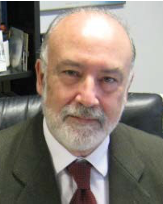Seminars
Prof. Eugenio Oñate
International Center for Numerical Methods in Engineering
Universitat Politècnica de Catalunya
Advanced Particle-Based Numerical Methods for Solving Multidisciplinary Problems Involving the Interaction of Particulate Fluids and Structures

ABSTRACT: We present recent developments in innovative and powerful computational procedures integrating particle-based and continuous techniques, such as the discrete element method (DEM) and the finite element method (FEM), for solving complex coupled problems involving the interaction of fluids containing particles of different sizes and structures. Micro and macro particles are either embedded in the fluid mesh or fully resolved, according to their relative size versus the analysis grid size. Micro particles are homogenized within the fluid using a multiscale Pseudo-Direct Numerical Simulation (P-DNS) approach [1, 2]. Free surface flows containing particles are modelled using the particle finite element method (PFEM, www.cimne.com/pfem) [3]. The procedure to model frictional contact conditions at fluid–solid and solid–solid interfaces is described. We present examples of application of the new particle based procedure to a wide range of multidisciplinary engineering problems involving interaction of particulate fluids and structures such as the motion of soil and rocks in water streams, the stability of breakwaters and constructions under sea waves, floods and tsunamis, the motion of landslides, the stability of rockfill dams under seepage and overtopping situations, the effect of explosions on soil/rock masses and constructions, drilling problems in the oil and gas industry, motion of ships in iced sea, lean edge erosion of wind turbine blades, and propagation of pathogens in air, among others.
References
1. Idelsohn, Gimenez, Larreteguy, Nigro, Sívori, and Oñate, The P-DNS method for turbulent fluid flows: An overview, Arch. Computat. Methods Eng. 31(2) (2024): 973–1021. https://doi.org/10.1007/s11831-023-10004-3
2. Idelsohn, Gimenez, Löhner, and Oñate, A multiscale approach for the study of particle-laden turbulent flows using a continuous model, Comput. Methods Appl. Mech. Engrg. 401 (2022): 115174. https://doi.org/10.1016/j.cma.2022.115174
3. Oñate, Celigueta, Idelsohn, Salazar, and Suárez, Possibilities of the particle finite element method for fluid–soil–structure interaction problems, Comput. Mech. 48 (2011): 307–318. https://doi.org/10.1007/s00466-011-0617-2
BIOGRAPHY: Eugenio Oñate is Emeritus Professor of Structural and Continuum Mechanics at the School of Civil Engineering in the Technical University of Catalonia (UPC, www.upc.edu). His research has focused on the development of numerical methods for solving problems in structural mechanics, fluid dynamics, and coupled situations in engineering sciences. His scientific contributions are of particular relevance for solving complex multidisciplinary problems in the fields of civil, industrial, aerospace, marine, and naval engineering, among others. He has supervised 71 PhDs (completed). He has supervised the career towards tenure of 49 PostDocs. He has published 498 articles in Journal Citation Reports (JCR) journals. He has an h-index of 85 (Google Scholar). He is the highest cited civil engineer in Spain. He is author of two text books and editor of three international Book Series and of 57 books on different topics of computational mechanics. He is editor of the JCR journals "Archives of Computational Methods in Engineering" (since 1994, Springer), “Computational Particle Mechanics” (since 2014, Springer), and "Métodos Numéricos para Cálculo y Diseño en Ingeniería" (since 1985, Scipedia). He was founder of the International Center for Numerical Methods in Engineering (CIMNE, www.cimne.com) in 1987 and its Director up to May 2022. He was founder and first president of the Spanish Society of Numerical Methods in Engineering (1989–2004), founder and president of the European Community for Computational Mechanics in Applied Sciences (2000–2004), and president of the International Association for Computational Mechanics (2002-2010). He has received numerous awards, distinctions, and honorary degrees at international level. He has organized and chaired/co-chaired 58 scientific conferences worldwide. He has promoted the creation of several technology-based companies in Spain. Five of these companies’ market software and products derived from outcomes of his research. More information in www.cimne.com/eo